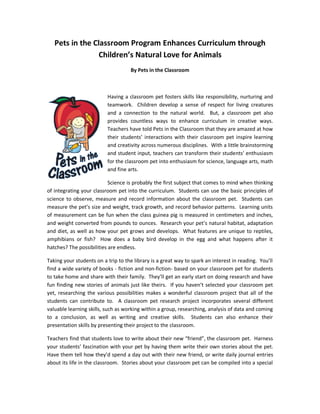Pets in the classroom program enhances curriculum through children
1 like2,644 views
The Pets in the Classroom Program, a teacher grants program, helps enhance curriculum through children's natural love for animals.
1 of 2
Download to read offline


Recommended
3 jo back to school night



3 jo back to school nightpjohnson78
╠²
Thank you for coming. I hope you have a better understanding of what your child will be learning and doing this year. Please feel free to contact me if you have any other questions. Have a great evening!Little zebra ppt edited



Little zebra ppt editedLittleZebra
╠²
The document describes the philosophy and curriculum of a preschool program. It aims to help children grow physically, socially, emotionally, and academically through play-based learning, exploration, and developing skills like problem-solving. Teachers guide children and create an environment for boundless learning opportunities including storytelling, art, music, and outdoor activities. The goal is to establish a strong foundation for future success by nurturing executive function skills before academic skills.Bc le sbla_science_k-2_animalhabitats



Bc le sbla_science_k-2_animalhabitatsKimberly Traspe
╠²
This document provides the procedures for a 3-day standards-based learning activity where students will research animal habitats using an online database. On day 1, students will choose an animal and find pictures of it online. On day 2, they will research the habitat of their animal and get into groups based on habitat. On day 3, each group will create a habitat collage and include cut-out pictures of animals that live there. The activity aims to teach students about how animals' features help them live in different environments.Class Newsletter _module 4



Class Newsletter _module 4maddiemogg
╠²
This presentation provides an overview of an upcoming classroom unit called "Pond Water and Pollywogs" that will teach students about frog life cycles and habitats over 12-15 weeks through hands-on activities like observing frog eggs hatch and creating an artificial frog habitat; the teacher will guide student learning and ensure all students participate in groups while documenting observations, and the unit meets state science and technology standards.Parent Welcome Meeting September 2015



Parent Welcome Meeting September 2015raygaff
╠²
This document provides information for parents about Year 2 at Dobcroft Infant School. It summarizes the curriculum, staff, routines, communication methods, homework policy, and other important details. The vision for the classroom is outlined as a happy, safe place where students can learn and be fulfilled. Working together is a key value, and parents are encouraged to participate through various activities.ProfessionalMissionStatement



ProfessionalMissionStatementKrista Kyker
╠²
The document discusses the author's motivation for pursuing a career in teaching. She was inspired by her mother, who was a dedicated teacher and role model. Through helping her own daughters learn and teaching them educational activities, the author realized she enjoyed the process of helping children learn. She wants to provide stability and direction for students who lack it at home. The author believes several key characteristics are important for teachers, such as humility, stability, empathy, unbiased thinking, and driving students to achieve their goals. Her goal is to mold children into productive members of society through education.Rancangan Pelajaran Harian



Rancangan Pelajaran Harianperwirapermata
╠²
The document outlines a Year 5 science lesson plan about food chains for 30 pupils. The lesson involves identifying animals' food sources, defining producers and consumers, explaining the concept of energy transfer through a food chain using plants and arrows, and demonstrating food chains using animal masks. Students will observe, classify, infer, communicate, predict, sequence, relate, attribute and generate ideas. The goals are for pupils to understand how to construct food chains and identify producers and consumers.Second Grade Open House - Shanghai American School, Pudong Campus



Second Grade Open House - Shanghai American School, Pudong Campussperobinson
╠²
Second Grade Open House - Shanghai American School, Pudong Campus: This slide show outlines the curriculum taught in second grade. It also outlines the units of study, assessment tools, information for parent volunteers, and homework expectations. Unit clil.



Unit clil.Yosiro
╠²
This CLIL unit is designed for 3rd cycle primary students to learn about different animals. It has several objectives including classifying animals, learning their abilities, and using vocabulary to describe animals. A variety of activities are outlined such as using flashcards and websites to learn vocabulary, reading a story, playing a classification game, and creating an animal wallchart. Considerations for diversity and assessing student learning are also discussed.Group project abington park slides



Group project abington park slidesjaccdd
╠²
This document discusses taking a Year 2 class to a local park to provide outdoor learning experiences to motivate and inspire students, especially in their writing. Outdoor learning has been shown to have long-lasting positive impacts on learning. The park would allow cross-curricular learning opportunities in a safe environment. Assessing students identified a need to improve their creative writing skills. Outdoor learning experiences can help build understanding and skills that transfer back to the classroom. Teachers should evaluate outdoor lessons to understand how it benefits students and fits with learning goals.Teacher Portfolio 2016



Teacher Portfolio 2016Heather Wulff
╠²
This document provides the resume and teaching philosophy of Heather Wulff, an experienced educator. She has a Master's degree in teaching and multiple subject teaching credentials. Her experience includes teaching various grades from preschool to 4th grade in several schools. She is currently teaching PreK-3 and has a strong record of collaborating with other teachers and developing engaging, standards-aligned curricula. Her teaching philosophy emphasizes meeting the needs of diverse learners through hands-on and project-based lessons that incorporate multiple intelligences. She aims to create a positive learning community and sees the potential to influence students' lives.Online assignment



Online assignmentneeshma71991
╠²
This document discusses the relevance and scope of using community-based resources to enhance science education. It argues that community resources can provide valuable learning experiences outside of the classroom. These resources include experts in various fields who can serve as guides, natural areas for hands-on study of science concepts, and local institutions like museums that complement classroom lessons. Taking students into the community helps make science more relevant, develops important skills, and allows them to learn from each other in collaborative experiences. Community-based learning supports a constructivist approach and helps connect classroom lessons to real-world applications of science.Why Home Learning Should Be More Self-Directed and Less Structured.pdf



Why Home Learning Should Be More Self-Directed and Less Structured.pdfKids Kingdom
╠²
Because of the coronavirus concern, pupils were forced to stay at home, and social media feeds were flooded with color-coded study regimens from well-meaning parents.The value of integration2



The value of integration2huutrinh
╠²
The document discusses the value of integrating curriculum across subject areas. It provides definitions of integration and describes how integrated curriculum combines subjects, emphasizes projects, uses diverse sources beyond textbooks, and shows relationships between concepts. Integrated curriculum benefits students by promoting real-world problem solving, collaboration, and motivation. Challenges to implementing integrated curriculum include the time needed for planning, scheduling between teachers, and adapting to changes in curriculum structure. The document provides examples of how to address these challenges and implement integration successfully.Graduate Presentation Night 2013



Graduate Presentation Night 2013Kaitlyn Gardner
╠²
This document provides the schedule and presentations for an elementary education graduate student presentation night. It includes the schedule with time allotted for welcome, three sessions of student presentations, and a social break. The document also provides information on 6 student presentation topics that will be covered, including using culinary exploration to teach math and science, implementing a narrative writing workshop, increasing algebraic thinking in second grade, teaching money skills, and using play-based learning centers. It provides context for the graduate student presentation event.Essay On Class Room



Essay On Class RoomPaper Writing Service Superiorpapers
╠²
Flipped Classroom Essay
Essay about The Future Classroom
Diversity in the Classroom Essay
A Creative Classroom Essay
Classroom Behavior Essay
Technology in the Classroom Essay example
Essay on Virtual Classrooms
Essay on The Smart Classroom
Classroom of the FutureANIMALS HABITSTS



ANIMALS HABITSTSraquelsolsona
╠²
This lesson plan explores animal habitats and includes activities to develop English skills. It focuses on vocabulary about animals and habitats, identifying habitats, and classifying animals. Activities include defining habitat, singing a song about habitats, drawing a favorite habitat, matching animals to habitats in pairs and a game identifying animal homes. The plan aims to engage students and assess their understanding through participation and self-assessment. Upon reflection, the teacher found students grasped key concepts but some activities needed adjustment for time management and developing additional skills like reading comprehension.FINAL Student Engagement - ALL 3 - Been through BDA, QA, Lizzie, Ossa, and Li...



FINAL Student Engagement - ALL 3 - Been through BDA, QA, Lizzie, Ossa, and Li...Kelsey Barrett, LPC Associate
╠²
This document provides tips for increasing student engagement and reading motivation for different grade levels. For upper elementary (3rd-5th grade), it recommends encouraging student ownership through co-creation activities like a thought board or building stories together. It also suggests utilizing technology like Istation to monitor progress and apps like ClassDojo to encourage digital storytelling. Interactive activities are recommended like vocabulary hunts and discussions to make connections to personal experiences. Student autonomy is emphasized by letting them select books as rewards for finishing work early. Reflective activities at the beginning and end of class aim to increase focus.Open House - SAS - 2012



Open House - SAS - 2012sperobinson
╠²
This document welcomes students to second grade and provides an overview of the curriculum and expectations for the school year. It introduces the three second grade teachers, Mrs. Nazli Ighani, Mrs. Sanna Robinson, and Mrs. Elizabeth Tucker, and summarizes the core subjects of reading, writing, word study, and math. It also outlines other topics in science, social studies, and assessments. Homework guidelines and opportunities for parent involvement are provided.Creating little botanist



Creating little botanistKatie Archer Olson
╠²
Creating Little Botanist was presented at the Anchorage Association for the Education of Young Children Conference February 2015 by Katie Olson. Katie has over 12 years experience working as the Directress at The Learning Tree Montessori and also serves as the Program Chair at Alaska Christian College in Soldotna. This session takes a look at the importance of creating a connection with the natural world in order to help young children self-regulate, focus, develop observation skills, and develop a life-long loving relationship with nature. This session helps outline how educators might develop a framework for an outdoor experiential classroom for children 3-11.Homework overview t3 2014



Homework overview t3 2014ernsteins
╠²
This document provides an overview of the term 3 curriculum and homework expectations for class 1E. Key points include:
- Literacy will focus on growth and changes through informative texts. Numeracy topics include fractions, patterns, and measurement.
- Homework includes a weekly talk topic, with options like animals or sports. A project on choosing and presenting about a small animal is also due in week 9.
- Ways parents can help include assisting with homework, volunteering during literacy groups, and communicating with teachers.Med560creativityshare



Med560creativityshareRegan Moore
╠²
This document provides 10 ways to bring creativity and critical thinking into the classroom. It suggests having students use technology like making movies or presentations. It also recommends collaborating across subjects and making content relevant by connecting it to students' interests. The document stresses the importance of asking questions that develop critical thinking and having students teach each other or prove their ideas. It advocates for hands-on activities and collaborative group discussions.Innovative ways of education in child care.pdf



Innovative ways of education in child care.pdfMontessori Academy of Arcadia
╠²
A child's journey toward lifetime learning begins with early childhood education. Child care facilities have the exceptional chance to use creative and interesting approaches to help young children develop a love of learning. The Child Care Duarte, CA, team has highlighted some exciting ways to transform child care into a playground for learning.Erasmus+ Project Based Learning activities for Inclusion 



Erasmus+ Project Based Learning activities for Inclusion despinarmenaki
╠²
Under the frame of the Erasmus+ project ŌĆ£Inclusive Learning for StudentsŌĆØ, Uk, Italy, Poland, Greece and Turkey cooperate to stimulate inclusion to every student and interest in the subjects of language, physics, history, science, environmental education, geography, physical education, design technology, ICT, music and Art.Understanding the Preschool Curriculum - What Your Child Will Learn.pdf



Understanding the Preschool Curriculum - What Your Child Will Learn.pdfPetite School House
╠²
Discover what your child will learn in preschool, from early reading to building social skills, and see how these foundations set them up for school success.Is your lesson a grecian urn



Is your lesson a grecian urnAntonis Stergiou
╠²
- Eric, a student teacher, created a 5-day unit on ancient Greek culture for 7th graders that involved students reading a short textbook chapter, answering questions, and creating papier-m├óch├® Grecian urns over 4 days. On the last day, students would take a vocabulary quiz.
- The author, feeling skeptical, asked Eric to show how the unit aligned with state standards about exploring diverse cultural elements and explaining how culture defined groups. Eric realized the urn project did not meet the standards.
- The article argues that many "hands-on" projects in classrooms, like Eric's urn project, are "Grecian Urns" that consume instructional time but do little1Running head LEARNING EXPERIENCE FOR PRESCHOOL CHILDREN1.docx



1Running head LEARNING EXPERIENCE FOR PRESCHOOL CHILDREN1.docxjesusamckone
╠²
The document summarizes three learning experiences developed for preschool children. The first experience involves children collecting rocks, sorting them by size and counting them, washing the rocks, painting letters of their names on them, and arranging them alphabetically. The second experience is a field trip where children observe and explore farm animals. The third involves children drawing pictures of animals they saw after the field trip. Assessment methods like observation, portfolios, and standardized tests are proposed to evaluate the learning experiences.Effective Product Variant Management in Odoo 18



Effective Product Variant Management in Odoo 18Celine George
╠²
In this slide weŌĆÖll discuss on the effective product variant management in Odoo 18. Odoo concentrates on managing product variations and offers a distinct area for doing so. Product variants provide unique characteristics like size and color to single products, which can be managed at the product template level for all attributes and variants or at the variant level for individual variants.More Related Content
Similar to Pets in the classroom program enhances curriculum through children (20)
Unit clil.



Unit clil.Yosiro
╠²
This CLIL unit is designed for 3rd cycle primary students to learn about different animals. It has several objectives including classifying animals, learning their abilities, and using vocabulary to describe animals. A variety of activities are outlined such as using flashcards and websites to learn vocabulary, reading a story, playing a classification game, and creating an animal wallchart. Considerations for diversity and assessing student learning are also discussed.Group project abington park slides



Group project abington park slidesjaccdd
╠²
This document discusses taking a Year 2 class to a local park to provide outdoor learning experiences to motivate and inspire students, especially in their writing. Outdoor learning has been shown to have long-lasting positive impacts on learning. The park would allow cross-curricular learning opportunities in a safe environment. Assessing students identified a need to improve their creative writing skills. Outdoor learning experiences can help build understanding and skills that transfer back to the classroom. Teachers should evaluate outdoor lessons to understand how it benefits students and fits with learning goals.Teacher Portfolio 2016



Teacher Portfolio 2016Heather Wulff
╠²
This document provides the resume and teaching philosophy of Heather Wulff, an experienced educator. She has a Master's degree in teaching and multiple subject teaching credentials. Her experience includes teaching various grades from preschool to 4th grade in several schools. She is currently teaching PreK-3 and has a strong record of collaborating with other teachers and developing engaging, standards-aligned curricula. Her teaching philosophy emphasizes meeting the needs of diverse learners through hands-on and project-based lessons that incorporate multiple intelligences. She aims to create a positive learning community and sees the potential to influence students' lives.Online assignment



Online assignmentneeshma71991
╠²
This document discusses the relevance and scope of using community-based resources to enhance science education. It argues that community resources can provide valuable learning experiences outside of the classroom. These resources include experts in various fields who can serve as guides, natural areas for hands-on study of science concepts, and local institutions like museums that complement classroom lessons. Taking students into the community helps make science more relevant, develops important skills, and allows them to learn from each other in collaborative experiences. Community-based learning supports a constructivist approach and helps connect classroom lessons to real-world applications of science.Why Home Learning Should Be More Self-Directed and Less Structured.pdf



Why Home Learning Should Be More Self-Directed and Less Structured.pdfKids Kingdom
╠²
Because of the coronavirus concern, pupils were forced to stay at home, and social media feeds were flooded with color-coded study regimens from well-meaning parents.The value of integration2



The value of integration2huutrinh
╠²
The document discusses the value of integrating curriculum across subject areas. It provides definitions of integration and describes how integrated curriculum combines subjects, emphasizes projects, uses diverse sources beyond textbooks, and shows relationships between concepts. Integrated curriculum benefits students by promoting real-world problem solving, collaboration, and motivation. Challenges to implementing integrated curriculum include the time needed for planning, scheduling between teachers, and adapting to changes in curriculum structure. The document provides examples of how to address these challenges and implement integration successfully.Graduate Presentation Night 2013



Graduate Presentation Night 2013Kaitlyn Gardner
╠²
This document provides the schedule and presentations for an elementary education graduate student presentation night. It includes the schedule with time allotted for welcome, three sessions of student presentations, and a social break. The document also provides information on 6 student presentation topics that will be covered, including using culinary exploration to teach math and science, implementing a narrative writing workshop, increasing algebraic thinking in second grade, teaching money skills, and using play-based learning centers. It provides context for the graduate student presentation event.Essay On Class Room



Essay On Class RoomPaper Writing Service Superiorpapers
╠²
Flipped Classroom Essay
Essay about The Future Classroom
Diversity in the Classroom Essay
A Creative Classroom Essay
Classroom Behavior Essay
Technology in the Classroom Essay example
Essay on Virtual Classrooms
Essay on The Smart Classroom
Classroom of the FutureANIMALS HABITSTS



ANIMALS HABITSTSraquelsolsona
╠²
This lesson plan explores animal habitats and includes activities to develop English skills. It focuses on vocabulary about animals and habitats, identifying habitats, and classifying animals. Activities include defining habitat, singing a song about habitats, drawing a favorite habitat, matching animals to habitats in pairs and a game identifying animal homes. The plan aims to engage students and assess their understanding through participation and self-assessment. Upon reflection, the teacher found students grasped key concepts but some activities needed adjustment for time management and developing additional skills like reading comprehension.FINAL Student Engagement - ALL 3 - Been through BDA, QA, Lizzie, Ossa, and Li...



FINAL Student Engagement - ALL 3 - Been through BDA, QA, Lizzie, Ossa, and Li...Kelsey Barrett, LPC Associate
╠²
This document provides tips for increasing student engagement and reading motivation for different grade levels. For upper elementary (3rd-5th grade), it recommends encouraging student ownership through co-creation activities like a thought board or building stories together. It also suggests utilizing technology like Istation to monitor progress and apps like ClassDojo to encourage digital storytelling. Interactive activities are recommended like vocabulary hunts and discussions to make connections to personal experiences. Student autonomy is emphasized by letting them select books as rewards for finishing work early. Reflective activities at the beginning and end of class aim to increase focus.Open House - SAS - 2012



Open House - SAS - 2012sperobinson
╠²
This document welcomes students to second grade and provides an overview of the curriculum and expectations for the school year. It introduces the three second grade teachers, Mrs. Nazli Ighani, Mrs. Sanna Robinson, and Mrs. Elizabeth Tucker, and summarizes the core subjects of reading, writing, word study, and math. It also outlines other topics in science, social studies, and assessments. Homework guidelines and opportunities for parent involvement are provided.Creating little botanist



Creating little botanistKatie Archer Olson
╠²
Creating Little Botanist was presented at the Anchorage Association for the Education of Young Children Conference February 2015 by Katie Olson. Katie has over 12 years experience working as the Directress at The Learning Tree Montessori and also serves as the Program Chair at Alaska Christian College in Soldotna. This session takes a look at the importance of creating a connection with the natural world in order to help young children self-regulate, focus, develop observation skills, and develop a life-long loving relationship with nature. This session helps outline how educators might develop a framework for an outdoor experiential classroom for children 3-11.Homework overview t3 2014



Homework overview t3 2014ernsteins
╠²
This document provides an overview of the term 3 curriculum and homework expectations for class 1E. Key points include:
- Literacy will focus on growth and changes through informative texts. Numeracy topics include fractions, patterns, and measurement.
- Homework includes a weekly talk topic, with options like animals or sports. A project on choosing and presenting about a small animal is also due in week 9.
- Ways parents can help include assisting with homework, volunteering during literacy groups, and communicating with teachers.Med560creativityshare



Med560creativityshareRegan Moore
╠²
This document provides 10 ways to bring creativity and critical thinking into the classroom. It suggests having students use technology like making movies or presentations. It also recommends collaborating across subjects and making content relevant by connecting it to students' interests. The document stresses the importance of asking questions that develop critical thinking and having students teach each other or prove their ideas. It advocates for hands-on activities and collaborative group discussions.Innovative ways of education in child care.pdf



Innovative ways of education in child care.pdfMontessori Academy of Arcadia
╠²
A child's journey toward lifetime learning begins with early childhood education. Child care facilities have the exceptional chance to use creative and interesting approaches to help young children develop a love of learning. The Child Care Duarte, CA, team has highlighted some exciting ways to transform child care into a playground for learning.Erasmus+ Project Based Learning activities for Inclusion 



Erasmus+ Project Based Learning activities for Inclusion despinarmenaki
╠²
Under the frame of the Erasmus+ project ŌĆ£Inclusive Learning for StudentsŌĆØ, Uk, Italy, Poland, Greece and Turkey cooperate to stimulate inclusion to every student and interest in the subjects of language, physics, history, science, environmental education, geography, physical education, design technology, ICT, music and Art.Understanding the Preschool Curriculum - What Your Child Will Learn.pdf



Understanding the Preschool Curriculum - What Your Child Will Learn.pdfPetite School House
╠²
Discover what your child will learn in preschool, from early reading to building social skills, and see how these foundations set them up for school success.Is your lesson a grecian urn



Is your lesson a grecian urnAntonis Stergiou
╠²
- Eric, a student teacher, created a 5-day unit on ancient Greek culture for 7th graders that involved students reading a short textbook chapter, answering questions, and creating papier-m├óch├® Grecian urns over 4 days. On the last day, students would take a vocabulary quiz.
- The author, feeling skeptical, asked Eric to show how the unit aligned with state standards about exploring diverse cultural elements and explaining how culture defined groups. Eric realized the urn project did not meet the standards.
- The article argues that many "hands-on" projects in classrooms, like Eric's urn project, are "Grecian Urns" that consume instructional time but do little1Running head LEARNING EXPERIENCE FOR PRESCHOOL CHILDREN1.docx



1Running head LEARNING EXPERIENCE FOR PRESCHOOL CHILDREN1.docxjesusamckone
╠²
The document summarizes three learning experiences developed for preschool children. The first experience involves children collecting rocks, sorting them by size and counting them, washing the rocks, painting letters of their names on them, and arranging them alphabetically. The second experience is a field trip where children observe and explore farm animals. The third involves children drawing pictures of animals they saw after the field trip. Assessment methods like observation, portfolios, and standardized tests are proposed to evaluate the learning experiences.FINAL Student Engagement - ALL 3 - Been through BDA, QA, Lizzie, Ossa, and Li...



FINAL Student Engagement - ALL 3 - Been through BDA, QA, Lizzie, Ossa, and Li...Kelsey Barrett, LPC Associate
╠²
Recently uploaded (20)
Effective Product Variant Management in Odoo 18



Effective Product Variant Management in Odoo 18Celine George
╠²
In this slide weŌĆÖll discuss on the effective product variant management in Odoo 18. Odoo concentrates on managing product variations and offers a distinct area for doing so. Product variants provide unique characteristics like size and color to single products, which can be managed at the product template level for all attributes and variants or at the variant level for individual variants.Helping Autistic Girls Shine Webinar ║▌║▌▀Żs



Helping Autistic Girls Shine Webinar ║▌║▌▀ŻsPooky Knightsmith
╠²
For more information about my speaking and training work, visit: https://www.pookyknightsmith.com/speaking/NUTRITIONAL ASSESSMENT AND EDUCATION - 5TH SEM.pdf



NUTRITIONAL ASSESSMENT AND EDUCATION - 5TH SEM.pdfDolisha Warbi
╠²
NUTRITIONAL ASSESSMENT AND EDUCATION, Introduction, definition, types - macronutrient and micronutrient, food pyramid, meal planning, nutritional assessment of individual, family and community by using appropriate method, nutrition education, nutritional rehabilitation, nutritional deficiency disorder, law/policies regarding nutrition in India, food hygiene, food fortification, food handling and storage, food preservation, food preparation, food purchase, food consumption, food borne diseases, food poisoningASP.NET Web API Interview Questions By Scholarhat



ASP.NET Web API Interview Questions By ScholarhatScholarhat
╠²
ASP.NET Web API Interview Questions By ScholarhatEntity Framework Interview Questions PDF By ScholarHat



Entity Framework Interview Questions PDF By ScholarHatScholarhat
╠²
Entity Framework Interview Questions PDF By ScholarHatRRB ALP CBT 2 Mechanic Motor Vehicle Question Paper (MMV Exam MCQ)



RRB ALP CBT 2 Mechanic Motor Vehicle Question Paper (MMV Exam MCQ)SONU HEETSON
╠²
RRB ALP CBT 2 Mechanic Motor Vehicle Question Paper. MMV MCQ PDF Free Download for Railway Assistant Loco Pilot Exam.Bß╗ś TEST KIß╗éM TRA GIß╗«A K├ī 2 - TIß║ŠNG ANH 10,11,12 - CHUß║©N FORM 2025 - GLOBAL SU...



Bß╗ś TEST KIß╗éM TRA GIß╗«A K├ī 2 - TIß║ŠNG ANH 10,11,12 - CHUß║©N FORM 2025 - GLOBAL SU...Nguyen Thanh Tu Collection
╠²
https://app.box.com/s/ij1ty3vm7el9i4qfrr41o756xycbahmgHannah Borhan and Pietro Gagliardi OECD present 'From classroom to community ...



Hannah Borhan and Pietro Gagliardi OECD present 'From classroom to community ...EduSkills OECD
╠²
Hannah Borhan, Research Assistant, OECD Education and Skills Directorate and Pietro Gagliardi, Policy Analyst, OECD Public Governance Directorate present at the OECD webinar 'From classroom to community engagement: Promoting active citizenship among young people" on 25 February 2025. You can find the recording of the webinar on the website https://oecdedutoday.com/webinars/
AI and Academic Writing, Short Term Course in Academic Writing and Publicatio...



AI and Academic Writing, Short Term Course in Academic Writing and Publicatio...Prof. (Dr.) Vinod Kumar Kanvaria
╠²
AI and Academic Writing, Short Term Course in Academic Writing and Publication, UGC-MMTTC, MANUU, 25/02/2025, Prof. (Dr.) Vinod Kumar Kanvaria, University of Delhi, vinodpr111@gmail.comComprehensive Guide to Antibiotics & Beta-Lactam Antibiotics.pptx



Comprehensive Guide to Antibiotics & Beta-Lactam Antibiotics.pptxSamruddhi Khonde
╠²
¤ōó Comprehensive Guide to Antibiotics & Beta-Lactam Antibiotics
¤ö¼ Antibiotics have revolutionized medicine, playing a crucial role in combating bacterial infections. Among them, Beta-Lactam antibiotics remain the most widely used class due to their effectiveness against Gram-positive and Gram-negative bacteria. This guide provides a detailed overview of their history, classification, chemical structures, mode of action, resistance mechanisms, SAR, and clinical applications.
¤ōī What YouŌĆÖll Learn in This Presentation
Ō£ģ History & Evolution of Antibiotics
Ō£ģ Cell Wall Structure of Gram-Positive & Gram-Negative Bacteria
Ō£ģ Beta-Lactam Antibiotics: Classification & Subtypes
Ō£ģ Penicillins, Cephalosporins, Carbapenems & Monobactams
Ō£ģ Mode of Action (MOA) & Structure-Activity Relationship (SAR)
Ō£ģ Beta-Lactamase Inhibitors & Resistance Mechanisms
Ō£ģ Clinical Applications & Challenges.
¤ÜĆ Why You Should Check This Out?
Essential for pharmacy, medical & life sciences students.
Provides insights into antibiotic resistance & pharmaceutical trends.
Useful for healthcare professionals & researchers in drug discovery.
¤æē Swipe through & explore the world of antibiotics today!
¤öö Like, Share & Follow for more in-depth pharma insights!How to Configure Deliver Content by Email in Odoo 18 Sales



How to Configure Deliver Content by Email in Odoo 18 SalesCeline George
╠²
In this slide, weŌĆÖll discuss on how to configure proforma invoice in Odoo 18 Sales module. A proforma invoice is a preliminary invoice that serves as a commercial document issued by a seller to a buyer.BISNIS BERKAH BERANGKAT KE MEKKAH ISTIKMAL SYARIAH



BISNIS BERKAH BERANGKAT KE MEKKAH ISTIKMAL SYARIAHcoacharyasetiyaki
╠²
BISNIS BERKAH BERANGKAT KE MEKKAH ISTIKMAL SYARIAHOne Click RFQ Cancellation in Odoo 18 - Odoo ║▌║▌▀Żs



One Click RFQ Cancellation in Odoo 18 - Odoo ║▌║▌▀ŻsCeline George
╠²
In this slide, weŌĆÖll discuss the one click RFQ Cancellation in odoo 18. One-Click RFQ Cancellation in Odoo 18 is a feature that allows users to quickly and easily cancel Request for Quotations (RFQs) with a single click.Meeting the needs of modern students?, Selina McCoy



Meeting the needs of modern students?, Selina McCoyEconomic and Social Research Institute
╠²
NAPD Annual Symposium
ŌĆ£Equity in our Schools: Does the system deliver for all young people?ŌĆØBß╗ś TEST KIß╗éM TRA GIß╗«A K├ī 2 - TIß║ŠNG ANH 10,11,12 - CHUß║©N FORM 2025 - GLOBAL SU...



Bß╗ś TEST KIß╗éM TRA GIß╗«A K├ī 2 - TIß║ŠNG ANH 10,11,12 - CHUß║©N FORM 2025 - GLOBAL SU...Nguyen Thanh Tu Collection
╠²
AI and Academic Writing, Short Term Course in Academic Writing and Publicatio...



AI and Academic Writing, Short Term Course in Academic Writing and Publicatio...Prof. (Dr.) Vinod Kumar Kanvaria
╠²
Pets in the classroom program enhances curriculum through children
- 1. Pets in the Classroom Program Enhances Curriculum through ChildrenŌĆÖs Natural Love for Animals By Pets in the Classroom Having a classroom pet fosters skills like responsibility, nurturing and teamwork. Children develop a sense of respect for living creatures and a connection to the natural world. But, a classroom pet also provides countless ways to enhance curriculum in creative ways. Teachers have told Pets in the Classroom that they are amazed at how their studentsŌĆÖ interactions with their classroom pet inspire learning and creativity across numerous disciplines. With a little brainstorming and student input, teachers can transform their studentsŌĆÖ enthusiasm for the classroom pet into enthusiasm for science, language arts, math and fine arts. Science is probably the first subject that comes to mind when thinking of integrating your classroom pet into the curriculum. Students can use the basic principles of science to observe, measure and record information about the classroom pet. Students can measure the petŌĆÖs size and weight, track growth, and record behavior patterns. Learning units of measurement can be fun when the class guinea pig is measured in centimeters and inches, and weight converted from pounds to ounces. Research your petŌĆÖs natural habitat, adaptation and diet, as well as how your pet grows and develops. What features are unique to reptiles, amphibians or fish? How does a baby bird develop in the egg and what happens after it hatches? The possibilities are endless. Taking your students on a trip to the library is a great way to spark an interest in reading. YouŌĆÖll find a wide variety of books - fiction and non-fiction- based on your classroom pet for students to take home and share with their family. TheyŌĆÖll get an early start on doing research and have fun finding new stories of animals just like theirs. If you havenŌĆÖt selected your classroom pet yet, researching the various possibilities makes a wonderful classroom project that all of the students can contribute to. A classroom pet research project incorporates several different valuable learning skills, such as working within a group, researching, analysis of data and coming to a conclusion, as well as writing and creative skills. Students can also enhance their presentation skills by presenting their project to the classroom. Teachers find that students love to write about their new ŌĆ£friendŌĆØ, the classroom pet. Harness your studentsŌĆÖ fascination with your pet by having them write their own stories about the pet. Have them tell how theyŌĆÖd spend a day out with their new friend, or write daily journal entries about its life in the classroom. Stories about your classroom pet can be compiled into a special
- 2. book to be shared with family and other classrooms. Weekly vocabulary lists can include words that pertain to your pet. Creativity can blossom through art as well. Students love to express their feelings for classroom pets through art. Try having them create an image with markers or crayons and another with paint. Experimenting with different materials is a great way to get your students familiar with art. Another great creative project is to have your students create collages of pictures and facts about their animal. This is a great way for them to express themselves while having fun incorporating information about their new friend. These are just a few of the ways a classroom pet can enhance the curriculum and inspire learning through a childŌĆÖs special bond with an animal.






